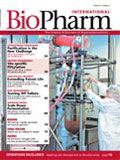Making Site-specific PEGylation Work
There are challenges aplenty in purification and analysis of PEGylated protein pharmaceuticals. Here are a variety of technical solutions, many concentrating on the chemistry of the linker.
The modification of proteins with polyethylene glycol (PEGylation) is an established technology that has many benefits in the biopharmaceutical industry. For instance, modifying proteins with multiple PEGs masks immunogenic sites and prevents neutralizing-antibody formation to certain proteins and therapeutic enzymes.1-3 Due to the amphiphilic nature of polyethylene glycol, PEGylation can also improve the solubility and physical-chemical stability of proteins.2,3

James E. Seely
PEGylation can increase the circulating half-life of proteins, especially smaller peptides and proteins, which normally have a rapid glomerular filtration rate and are cleared on the basis of size. PEGs have a high Stokes-radius-to-mass ratio. Attachment of one or two 10-20 kDa PEG molecules can increase the circulating half-life of small proteins and peptides several-fold, resulting in a much less frequent dosing regimen.4
In site-specific PEGylation, a significant portion of the biological activity of the protein can be maintained while increasing the half-life. Currently available products include PEGASYS (peginterferon alpha-2a) by Roche, Neulasta (pegfilgrastim) by Amgen, Somavert (pegvisomant) by Roche and PEG-INTRON (peginterferon alpha-2b) by Schering-Plough. Several other companies have site-specific PEGylated products in development.
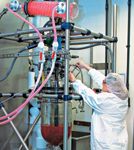
In this article, we present some of the challenges of developing commercially viable, site-specific PEGylated protein and peptide pharmaceuticals, with particular emphasis on the purification and analysis of PEGylated products and the analysis of the PEG linkers.
PEGYLATION REAGENTS
The most common modification agents, or linkers, are based on methoxy PEG (mPEG) molecules (Figure 1). Their activity depends on adding a protein-modifying group to the alcohol end. In some instances polyethylene glycol (PEG diol, Figure 1) is used as the precursor molecule. The diol is subsequently modified at both ends in order to make a hetero- or homo-dimeric PEG-linked molecule (as shown in the example with PEG bis-vinylsulfone).

Figure 1. Structures of Methoxy Polyethylene Glycol (mPEG) and Polyethylene Glycol (PEG diol)
PEGylation at Cysteinyl Residue
Proteins are generally PEGylated at nucleophilic sites such as unprotonated thiols (cysteinyl residues) or amino groups.
2,5,6
Examples of cysteinyl-specific modification reagents include PEG maleimide, PEG iodoacetate, PEG thiols, and PEG vinylsulfone.
2,5,6
All four are strongly cysteinyl-specific under mild conditions and neutral to slightly alkaline pH but each has some drawbacks. The amide formed with the maleimides can be somewhat unstable under alkaline conditions
7
so there may be some limitation to formulation options with this linker. The amide linkage formed with iodo PEGs is more stable, but free iodine can modify tyrosine residues under some conditions. PEG thiols form disulfide bonds with protein thiols, but this linkage can also be unstable under alkaline conditions. PEG-vinylsulfone reactivity is relatively slow compared to maleimide and iodo PEG; however, the thioether linkage formed is quite stable. Its slower reaction rate also can make the PEG-vinylsulfone reaction easier to control.
Site-specific PEGylation at native cysteinyl residues is seldom carried out, since these residues are usually in the form of disulfide bonds or are required for biological activity. On the other hand, site-directed mutagenesis can be used to incorporate cysteinyl PEGylation sites for thiol-specific linkers. The cysteine mutein must be designed such that it is accessible to the PEGylation reagent and is still biologically active after PEGylation.
A less obvious concern is the stability of the mutein during the PEGylation process. PEGylation reaction conditions (usually neutral to slightly alkaline pH) also favor disulfide-linked dimerization and aggregation. For PEGylation reaction conditions, the reactive cysteinyl residues are in the thiolate anion form. This strong nucleophile not only reacts with PEGylation reagents, but with other cysteinyl residues and disulfide bonds, resulting in disulfide-linked dimers and aggregates.8 As can be seen in Figure 2, when two muteins were PEG-ylated, mutein B exhibited a high degree of disulfide-linked dimerization during the PEGylation reaction, which led to low PEGylation yields.
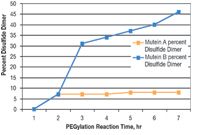
Figure 2. Comparison of the Rate of Conversion of Cysteine Muteins A and B to Disulfide Dimer Under PEGylation Conditions
PEGylation at Amino Group
Amine-specific modification agents include PEG NHS ester, PEG tresylate, PEG aldehyde, PEG isothiocyanate, and several others.
2,5,6
All react under mild conditions and are very specific for amino groups. The PEG NHS ester is probably one of the more reactive agents; however, its high reactivity can make the PEGylation reaction difficult to control at large scale. PEG aldehyde forms an imine with the amino group, which is then reduced to a secondary amine with sodium cyanoborohydride. Unlike sodium borohydride, sodium cyanoborohydride will not reduce disulfide bonds.
9
However; this chemical is highly toxic and must be handled cautiously, particularly at lower pH where it becomes volatile.
Due to the multiple lysine residues on most proteins, site-specific PEGylation can be a challenge. Fortunately, because these reagents react with unprotonated amino groups, it is possible to direct the PEGylation to lower-pK amino groups by performing the reaction at a lower pH. Generally the pK of the alpha-amino group is 1-2 pH units lower than the epsilon-amino group of lysine residues. By PEGylating the molecule at pH 7 or below, high selectivity for the N-terminus frequently can be attained.5,10 However; this is only feasible if the N-terminal portion of the protein is not required for biological activity. Still, the pharmacokinetic benefits from PEGylation frequently outweigh a significant loss of in vitro bioactivity, resulting in a product with much greater in vivo bioactivity regardless of PEGylation chemistry.
OPTIMIZING PEGYLATION CONDITIONS
There are several parameters to consider when developing a PEGylation procedure. Fortunately, there are usually no more than four or five key parameters. The "design of experiments" approach to optimization of PEGylation conditions can be very useful.
11,12
For thiol-specific PEGylation reactions, parameters to consider include: protein concentration, PEG-to-protein ratio (on a molar basis), temperature, pH, reaction time, and in some instances, the exclusion of oxygen. (Oxygen can contribute to intermolecular disulfide formation by the protein, which will reduce the yield of the PEGylated product.) The same factors should be considered (with the exception of oxygen) for amine-specific modification except that pH may be even more critical, particularly when targeting the N-terminal amino group.
For both amine- and thiol-specific modifications, the reaction conditions may affect the stability of the protein. This may limit the temperature, protein concentration, and pH. In addition, the reactivity of the PEG linker should be known before starting the PEGylation reaction. For example, if the PEGylation agent is only 70 percent active, the amount of PEG used should ensure that only active PEG molecules are counted in the protein-to-PEG reaction stoichiometry. How to determine PEG reactivity and quality will be described later.
When using PEG aldehyde, the presence of cyanates and other contaminants in the sodium cyanoborohydride reducing agent can inhibit the PEGylation reaction.13 For this reason, we typically test for these cyanates as part of the release testing for sodium cyanoborohydride. Including a PEGylation reaction as part of the sodium cyanoborohydride release testing helps ensure that no other components in this reagent inhibit PEGylation. After all, the cost of the reducing agent is miniscule compared to the cost of the PEG aldehyde and the protein being modified.

Figure 3. Structure 20 kDa PEG-linked Protein Dimer
PURIFICATION OF THE PEGYLATED PROTEIN PRODUCT
The principles of the following example of the purification of PEGylated protein can be applied to other PEGylated products. The product in this example is a PEG-linked homodimer (PEG dimer, Figure 3) made from 20 kDa PEG bis-vinylsulfone (Figure 4). A number of reaction components and side products must be removed, most notably PEG monomer and unPEGylated protein.

Figure 4. Structure of 20 kDa PEG Bis-vinylsulfone
Size-exclusion chromatography (SEC) can separate unPEGylated from PEGylated proteins but not the PEG dimer from the PEG monomer. Hydrophobic interaction chromatography generally works poorly for this application (depending on the hydrophobicity of the protein relative to the PEG) because PEGs also bind to hydrophobic interaction chromatography media.14
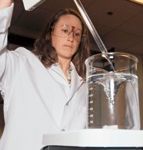
PEGylation of CT-322 AdNectin
In general, the method of choice is ion-exchange chromatography. In this instance, cation-exchange chromatography using SP-Sepharose HP media (GE Healthcare) was used. The column was equilibrated and run at pH 3 using a linear 250-500 mM NaCl gradient at 0.15 column-volumes/min. Column loading was 4-6 (mg total protein)/(mL bed volume). As shown in Figure 5, the separation of the PEG dimer from the other components in the reaction mixture appeared to be based on the PEG-to-protein ratio (the retention time for PEG monomer is less than that for the PEG dimer, which is less than that for the unPEGylated protein). There is no net charge difference between these molecules at pH 3, which suggests that the PEG somehow interfered with or weakened the interaction of the protein with the cation-exchange media.
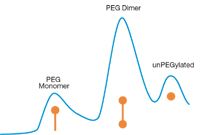
Figure 5. SP-Sepharose HP Elution Profile for the Purification of 20 kDa PEG Dimer. (PEG monomer is a PEG molecule where protein is bound to only one end.)
In order to further explore this hypothesis, we ran the PEGylation mixture on an anion exchanger (Q-Sepharose HP, GE Healthcare) at pH 11 using a 0-500 mM NaCl gradient. As shown in Figure 6, the elution of these products was in the same order as seen for the cation exchanger. This suggests that PEG exerts a shielding or steric effect, which weakens the interaction of the protein with the medium. For this protein, and every other protein we have PEGylated, the elution order with preparative ion-exchangers has been determined by the PEG-to-protein mass ratio (Figure 7).
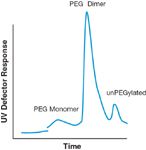
Figure 6. Q-Sepharose HP Elution Profile for the Purification of 20 kDa PEG Dimer. (The elution profile shows the same order of elution as Figure 5.)
ANALYSIS OF THE PEGYLATED PROTEIN PRODUCT
Characterization of PEGylated proteins is difficult due to the fact that the PEG molecule is more polydisperse than the protein and imparts size heterogeneity to the conjugated protein. Size-exclusion chromatography (SEC) has often been used to characterize these conjugates. This tool is limited by the extra peak-broadening due to the polydispersity of the PEG conjugate. SEC also will not detect "PEGyation site isomers" in which the protein is PEGylated at different residues. This is particularly relevant to amine-specific modifications, where there may be a number of different mono-PEGylation site isomers at different amino groups.

Figure 7. Protein-to-PEG Mass Ratio determines order of Elution of PEGylated Proteins on Ion-exchangers (Retention time increases from right to left.)
We have found that cation-exchange HPLC is a powerful tool for resolving these PEGylation site isomers. For example, see the protein PEGylated with mPEG aldehyde in Figure 8. After PEGylation, the protein was purified with SP-Sepharose HP under conditions similar to those used for the PEG dimer. Figure 9 shows a typical chromatograph of the purified product run using a PolyCAT A cation-exchange HPLC column (PolyLC).
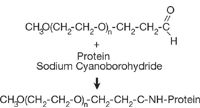
Figure 8. Methoxy PEG Aldehyde (propionaldehyde, in this case) PEGylation in the Presence of Sodium Cyanoborohydride forms a Secondary Amine Linkage with Protein.
To determine the protein's PEGylation sites, Lys-C digests were done on samples from each purified peak. PEG prevents Lys-C from cleaving next to the PEGylated lysine due to steric hindrance. Therefore, the peptide following the PEGylated lysine remains attached. The cycle containing PEGylated lysine does not elute from the sequencer column in the gradient portion of the analysis and a blank cycle occurs in the sequence at the site of PEGylation.
Approximately 85 percent of the product was found to be PEGylated on the N-terminal amino group (main peak, 23.5 min, Figure 9). Five other PEGylation-site isomers were found (XP1, XP2, XP3, XPS1, and XL1), each corresponding to monoPEGylated variants at different lysine residues. A small amount (<1 percent) of diPEGylated material (XP4 and XP5), which resulted from PEGylation at the N-terminus, plus one lysine residue, and a small amount of unPEGylated product (~0.1 percent) eluted in the column wash. In addition, all of the lysine PEGylation variants were found to be biologically active. The pattern of PEG-site-isoform distribution shown in Figure 9 (~85 percent N-terminal modification, ~5 percent XP3, etc.) remained consistent from lot to lot. A similar approach can be used with other PEG chemistries, regardless of PEG molecular weight.
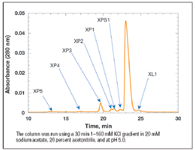
Figure 9. Cation Exchange HPLC Chromatography of PEG Aldehyde Modified Protein Showing Separation of Different PEGylation Site Isomers on PolyCAT A (Poly LC, Inc.)
QUALITY ISSUES WITH 20 KDA PEG BIS-VINYLSULFONE
While developing the PEG dimer process with a 20 kDa PEG bis-vinylsulfone (Figure 4) linker, we observed considerable variability in the yield and purity of the dimer. This variability seemed to correlate with different lots of linker. One of the main impurities observed was a low molecular weight (5â10 kDa) PEG monomer, which tended to co-elute with the dimer (Figure 7). These PEGylation variants were formed from low-molecular-weight PEG-monovinylsulfones in the linker. The low-molecular-weight PEGs not only compete with the linkers in the PEGylation reaction (resulting in lower yields), they also form a side product that is difficult to remove from the PEG dimer (resulting in lower purity).
Analytical methods have limitations. Nuclear magnetic resonance (NMR) can tell us about the ratio of vinylsulfone to PEG backbone, and SEC can tell us about size homogeneity. If the PEG is an intact 20 kDa PEG, NMR can tell us the relative substitution of vinylsulfone on the PEG (in other words, does it have vinylsulfone on both ends or only one). However, if the PEG fragments into two smaller PEG monovinysulfones, NMR would be unable to distinguish these from a single 20 kDa bis-vinylsulfone. SEC can distinguish between PEGs of different sizes but cannot determine the extent of vinylsulfone substitution.
Therefore, we developed a single method that could tell us about both the size heterogeneity and the degree of vinylsulfone substitution. Derivatization of the PEG linker with an excess of o-thiobenzoic acid (OTBA), which reacts with the vinylsulfone moiety, followed by chromatography on reversed-phase HPLC (RP-HPLC) using an Astec C4 polymer-based column (Advanced Separations Technologies, Inc.), enabled us to separate PEGs both on the basis of size and vinylsulfone substitution. PEGs bind to reversed phase media, but the OTBA binds more tightly and elutes after the PEG peaks (see Figure 10). Thus, the PEGs' retention times are modulated by the OTBA, and the elution order is determined by the OTBA-to-PEG ratio. The OTBA also allows us to monitor the PEG eluate by UV absorbance at 254 nm.
As you can see in Figure 10, this reversed-phase method clearly separates the problematic low-molecular-weight PEG monovinylsulfones (shown by the arrow in Figure 10) from the 20 kDa PEG bis-vinylsulfone and other PEG variants. The area percent of the 20 kDa PEG bis-vinylsulfone peak correlated quite well with the final recovery of PEG dimer.
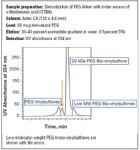
Figure 10. Reversed Phase HPLC Assay for 20 kDa PEG Bis-vinylsulfone
This RP-HPLC method is used as a release assay to ensure that the 20 kDa PEG bis-vinylsulfone is of adequate quality (low on monomer). Variations of this method are being used to assess the quality of other PEG linkers, such as mPEG aldehyde.
STABILITY ISSUES WITH THE LINKER
Accelerated stability studies with the PEG dimer revealed a very rapid rate of degradation (as determined by SEC). Even more disconcerting, the degradation rate was variable and appeared to be related to the lot of 20 kDa PEG bis-vinylsulfone used to make the PEG dimer. A gradual reduction in the size of the PEG dimer and a concomitant increase in lower-molecular-weight product of various sizes was observed by size-exclusion HPLC after two weeks at 35ºC. This observation was consistent with a breakdown in the PEG backbone at random sites.
PEG is known to degrade by auto-oxidation, which can ultimately lead to chain scission.13,15 This reaction can be initiated by heat, light, or transition metals and is propagated by oxygen or other oxidizers. The original process for making the linker included not only a heating step in the presence of a transition metal but also an oxidation step using hydrogen peroxide. It was hypothesized that the process of making the linker could generate low-molecular-weight PEGs and initiate damage to the PEG backbone that could eventually result in chain scission even after attachment to the protein.
For this reason, an alternative proprietary route to synthesize a linker was developed that eliminated the use of peroxides, transition metals, and high temperatures. The 20 kDa PEG bis-vinylsulfone made with this new process produces a PEG dimer with markedly better stability (Figure 11).
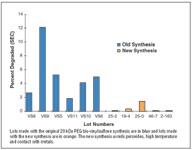
Figure 11. Degradation of the 20 kDa PEG Dimers Made from Different Lots of 20 kDa PEG Bis-vinylsulfone (as determined by size exclusion HPLC)
In conclusion, it is crucial to consider how PEG linkers are produced in order to ensure a product of adequate quality and stability. Keep the heat to a minimum and design vessels so there are no local hot spots, such as a high skin temperature. We also recommend that glass-lined vessels be used to avoid contact with stainless steel. All in all, minimize thermal contact time in order to ensure PEG quality. In addition to PEG linker analysis, accelerated stability studies with the PEGylated product should be performed any time there is a significant process or scale change in the production of the PEG linker.
QUALITY ISSUES WITH mPEG ALDEHYDE
An important factor for ensuring consistent PEGylation yields and product quality is the PEG-to-protein ratio in the PEGylation mixture. The amount of mPEG converted to mPEG aldehyde can vary from batch to batch.
Therefore, an assay is necessary to determine the molar percent mPEG aldehyde. This helps develop a better-controlled mPEG aldehyde production process. The assay can be used to adjust the PEG-to-protein ratio during PEGylation in accordance with the amount of active mPEG aldehyde per unit protein.
Based on our experience with the reversed phase assay used for 20 kDa PEG bis-vinylsulfone, we derivatized the mPEG aldehyde with p-aminobenzoic acid (PABA) prior to running through the Astec C4 column. Both an evaporative light scattering (ELS) detector and a UV detector (upstream from the ELS detector) were used to monitor the column eluate. After derivatization with PABA, the derivatized PEGs' retention time will shift about a minute later (Figure 12). The UV detector confirms the positions of the derivatized PEGs and the ELS detector detects both underivatized and derivatized PEGs. The amount of active mPEG aldehyde can be determined from the percent area of the derivatized mPEG aldehyde peak from the ELS trace. A similar analytical approach can be used for other amine-specific linkers, regardless of the PEG's molecular weight.
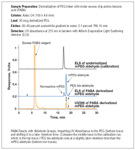
Figure 12. Reversed-Phase HPLC Assay for mPEG Aldehyde.
BIS-ALDEHYDE
During the polymerization process for mPEG, the presence of trace amounts of water in the reaction milieu results in the formation of ethylene glycol from the ethylene oxide substrate (Figure 13). The ethylene glycol reacts with ethylene oxide to form PEG diol, which is subsequently converted to PEG bis-aldehyde. This side reaction poses a particular problem for mPEGs larger than 25 kDa. The PEG bis-aldehyde can compete for binding sites on the protein with mPEG aldehyde to form PEG protein dimers.
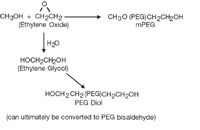
Figure 13. Polymerization Reaction for the Production of mPEG, Showing the Side Reaction to Make PEG Diol in the Presence of Water
The PABA derivatization used with reversed-phase chromatography determines the amount of PEG bis-aldehyde in our mPEG aldehyde preparations. This material, when derivatized, runs later on the reversed-phase column (Figure 12, middle chromatogram). This assay ensures that the amount of PEG bis-aldehyde in the material we receive is acceptably low.
SUMMARY
A number of factors must be considered when developing protein PEGylation conditions, including the PEG-to-protein ratio, pH, reaction time, and temperature. Generally, arriving at an optimal PEGylation procedure is fairly straightforward. Preparative ion-exchange chromatography can separate PEGylated products based on their protein-to-PEG mass ratio and is one of the best ways we have found to purify PEGylated proteins. Ion-exchange HPLC chromatography is an excellent tool for the analysis of PEGylated products, particularly for the separation of PEGylation site isomers (products PEGylated at different sites on protein).
PEG-linker quality can be a major hindrance in developing PEGylated products. The analytical tools and some of the other considerations we have described here can help ensure a robust PEGylation process and a PEGylated protein of consistent purity and stability.
ACKNOWLEDGEMENTS:
The authors would like to acknowledge the contributions of John Wilson, David Kachensky, Prabha Ibrahim, Hsi Meng, and Milton Harris.
James E. Seely, Ph.D., is associate director of process development, purification process development section, at Amgen Colorado Process Development, 4000 Nelson Road, Longmont, CO 80503, 303.401.1229, fax 303.401.4403, jseely@amgen.com. Scott D. Buckel, Ph.D., is sr. principal scientist for process development, analytical science section at Amgen, 303.401.1636, sbuckel@amgen.com. Pat D. Green is scientist in process development, analytical science section, at Amgen, 303.401.1252, pgreen@amgen.com. Carl W. Richey is senior associate scientist, purification process development section, at Amgen, 303.401.1224, crichey@amgen.com
REFERENCES
1. Abuchowski A, et al. Alteration of immunological properties of bovine serum albumin by covalent attachment of polyethylene glycol.
J. Biol. Chem.
1977; 252:3578.
2. Nucci ML, et al. The therapeutic value of poly (ethylene glycol)-modified proteins. Adv. Drug Del. Rev. 1991; 6:133-151.
3. Inada Y, et al. Biological and biotechnological application and PEG and PM-modified proteins. TIBTECH. 1995; 13:86-90.
4. Katre NV, et al. Chemical modification of recombinant interleukin 2 by polyethylene glycol increases its potency in the murine Meth A sarcoma model. Proc. Natl. Acad. Sci. USA 1987; 84:1487-1491.
5. Harris JM, et al. Synthesis and characterization of poly (ethylene glycol) derivatives. J. Poly. Sci: Polymer Chem. Ed. 1984; 22:341-352.
6. Bailon P, Berthold W. Polyethylene glycol-conjugated pharmaceutical proteins. PSTT. 1998; 1:352-356.
7. Ishi Y, Lehrer SS. Effect of the state of the succinimido-ring on the fluorescence and structural properties of pyrene maleimide-labeled toropomyosin. Biophys. J. 1986; 50:75.
8. Wetlaufer DB, Nonenzymatic formation and isomerization of protein disulfides, Methods in Enzymology. 1984; 107:301-304.
9. Jentoft N, Dearborn DG. Labeling of proteins by reductive methylation using sodium cyanoborohydride. J. Biol. Chem. 1979: 254:4359.
10. Kinstler O, et al. Characterization and stability of N-terminally PEGylated rhG-CSF. Pharm. Res. 1996; 13(7):996.
11. Kelley B. Establishing process robustness using designed experiments. In Sofer G, Zabriskie D, editors. Pharmaceutical Process Validation. New York: Marcel Dekker Press, Inc.; 1999. pp. 29-60.
12. Haaland P. Experimental Design in Biotechnology. New York: Marcel Dekker, Inc.;1989.
13. Seely JE, et al. Issues encountered in the production of site-specific monoPEGylated therapeutic proteins. Polymer Preprints 1997; 38(1):572-673.
14. Seely JE, Richey CW. Use of ion-exchange chromatography and hydrophobic interaction chromatography in the preparation and recovery of polyethylene glycol-linked proteins. J. Chrom. A. 2001; 908:235-241.
15. McGary CW Jr. Degradation of poly(ethylene oxide). J. Poly. Sci. 1960; 46:51-57.
